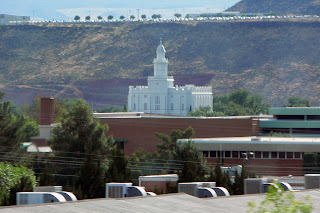
It doesn't take long for cedar trees to spring up (hence the town Cedar City). You can see that the dirt itself is still rather red, though. I believe Kolob Canyon is just on the other side of the gap in the mountains in the first picture.





Provo and Salt Lake are 40 miles apart, and between them is one continuous string of settlement. You may have seen this place in the film Footloose; it's Lehi. (Unlike the characters in movie, however, Mormons do dance.)

Past Lehi is Point of the Mountain, which used to be sort of desolated, only now it's the junction between the two valleys, populationwise. But no matter how many lanes they add to the freeway, people continue to hang-glide in this area. The updrafts must be good.

Around Ogden, the northern arm of the Great Salt Lake gets close to the freeway. The thing is huge! There's a wild bird refuge there, too.

Tremonten is the last town on 15 before Idaho. Here, you can stay on 15 through Idaho towards Montana, or split to the west for Boise. The gap in the mountains is I think a pass to get to Logan (Utah) and Cache Valley.

I-70 starts in the middle of Utah and runs east. It gets near Canyonlands, I think. Utah was settled by Mormons and miners, and it's always very obvious which sort of town it is when you drive through. (The Mormon towns are surrounded by lush, irrigated fields and planned streets and houses; the miner towns are dusty, deserty, and have interesting-looking old machinery up in the hills.)


I-80 also runs through the state and runs west-east. It goes through Salt Lake City and comes out in Wyoming.
























